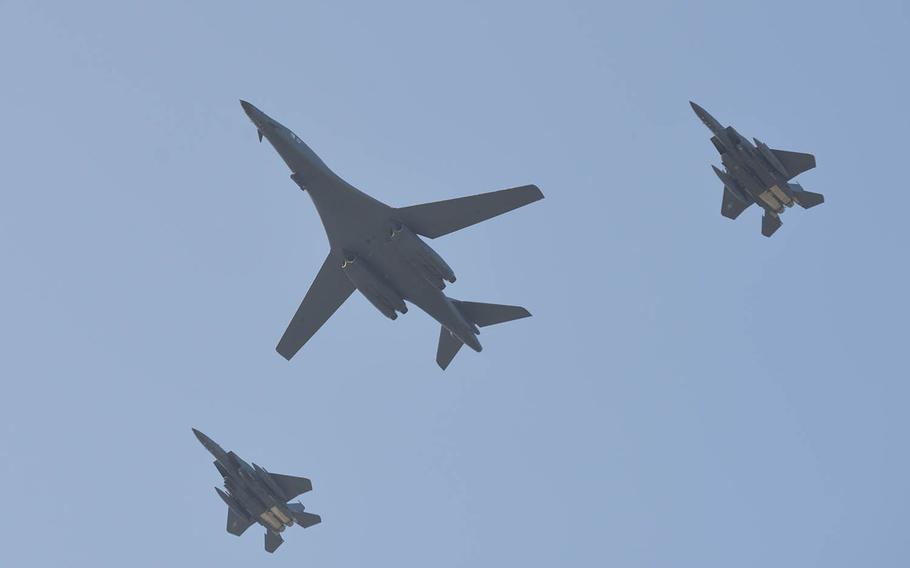
An Air Force B-1B Lancer bomber flies alongside two South Korean fighters over the Korean Peninsula, Oct. 21, 2017. (Alex Echols/U.S. Air Force photo)
SEOUL, South Korea — A U.S. supersonic bomber flanked by state-of-the-art fighter jets flew over South Korea Wednesday in a show of force a week after the North test-fired its most powerful missile.
The flyover happened as the two allied air forces are in the midst of joint war games known as Vigilant Ace, which have prompted North Korea to warn they were pushing the divided peninsula “to the brink of nuclear war.”
The United States frequently sends bombers from Andersen Air Force Base, Guam, to the peninsula after North Korean missile tests. But the inclusion on Wednesday of F-22 Raptors and two variants of the F-35 Lightning II was likely to infuriate the reclusive communist state even more.
The Air Force sent only one bomber, a departure from previous flyovers that involved two. Most recently a pair of Lancers flew over the peninsula ahead of President Donald Trump’s first official visit to the region last month.
"Through the exercise, the U.S. and South Korean air forces have demonstrated the alliance's strong will and capability for strong retaliation against North Korea's nuclear and missile threats," South Korea’s Joint Chiefs of Staff said in a statement.
The warplanes conducted a simulated bombing drill on the Pilsung range on the east coast, it said, adding that Washington and Seoul also sharpened their readiness to deploy a "rapid response force" by improving their interoperability and joint fighting powers.
The bomber began with a bilateral exercise with Japanese fighter jets, then flew to South Korea to join two Raptors, two Air Force F-35As, two Marine Corps F-35Bs and four South Korean fighters for an airpower demonstration during Vigilant Ace, according to the 7th Air Force.
“The U.S. and its regional allies and partners have long conducted routine exercises to maintain readiness and demonstrate the strength of their alliances,” the Air Force said in a statement.
Tensions have risen to the highest level in decade as North Korea and Trump spar over the communist state’s nuclear weapons program.
The president has threatened to unleash “fire and fury” and to “totally destroy” the North if he must defend the U.S. and its allies. Pyongyang, meanwhile, has defied the warnings and punishing economic sanctions to make surprisingly swift progress in its efforts to develop a nuclear-capable missile that could target the U.S. mainland.
It has test-fired three intercontinental ballistic missiles this year, most recently on Nov. 29 when it launched an ICBM that flew farther and higher than the others.
The F-22s and F-35s joined the annual air force drills Vigilant Ace for the first time this year. The five-day exercise, which ends on Friday, involved more than 200 aircraft and 12,000 U.S. personnel.
Stars and Stripes reporter Yoo Kyong Chang contributed to this report.
gamel.kim@stripes.com Twitter: @kimgamel